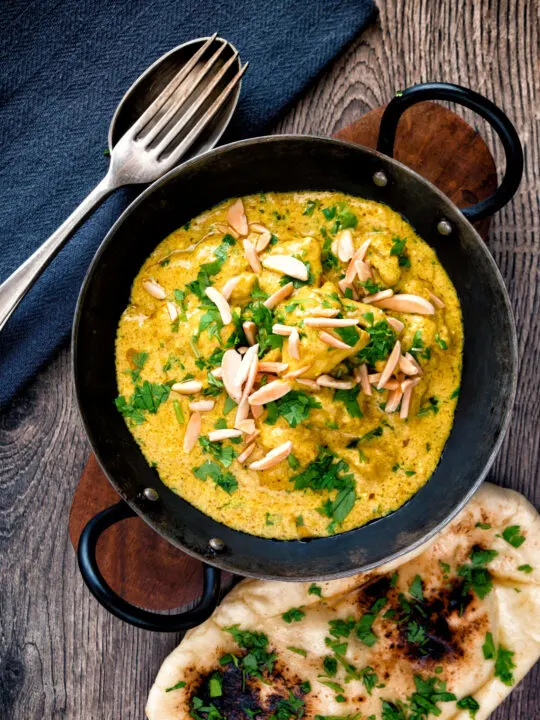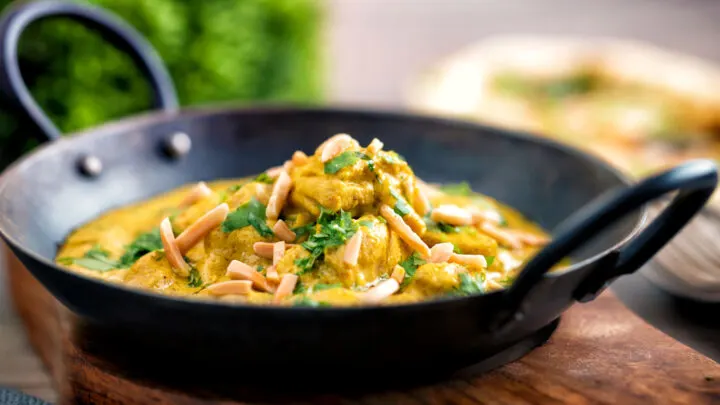Chicken korma a delicious mildly spiced Indian Curry featuring perfectly cooked chunks of chicken thigh in a thick and creamy yoghurt sauce.
Turmeric, garam masala and a pinch of chilli powder lead the way on the spices, before a tadka featuring coriander seeds, cloves, cardamom and cinnamon is added at the end.
Nobody Puts Curry in the Korma.
The chicken korma is a curry with a but of a bad rep in the world I grew up in. Among many things it was called a curry for people who do not like curry!
The reason for this is that it was the item on the menu that evolved into a dish that a waiter could recommend to British diners that would not be too “spicy”.
It is a long way from a garlic chilli chicken, Chicken Rogan Josh, chicken Ceylon and Beef Vindaloo!
My version is NOT that korma! My perfect chicken korma is light and fragrant with a thick tart yoghurt “gravy”.
In many ways it is similar to a chicken passanda.
My influence for this chicken korma recipe came from a recipe I stumbled on by Atul Kochhar.
The first Indian chef to receive a Michelin star and the owner of a restaurant that I consider to be one of the best I that have ever eaten in, ‘Benares’!
This recipe reduces the amount of cream usually used and sticks with yoghurt. This adds a delicious tartness to the fragrant spices in the silky korma sauce.
My recipe also does not use coconut milk, a common and relatively modern addition to chicken korma recipes.
Frequently Asked Questions
My sauce has started to split what did I do wrong?
There are two things that usually increase the risk of this chicken korma sauce splitting or separating.
The first is using low-fat yoghurt, this increases the instability of the dish. The second is boiling the sauce too hard, keep it on a gentle simmer for best results.
Can I rescue a separated sauce?
Yes, you may be able to bring it back together so long as you catch the dish early enough.
Remove the dish from the heat immediately and quickly whisk in some high fat (30-40%) cream or half and egg yolk.
Can I use low-fat yoghurt?
As I mentioned above, high fat yoghurt is inherently less stable and runs a much higher risk of the sauce separating.
You can whisk flour into the yoghurt which will stabilise it a little, the amount will really depend on the fat content of the yoghurt. I would personally advise against it.
Can I use chicken breast rather than chicken thigh?
Yes, this chicken korma is just as good with chicken breast as it is with chicken thighs because of the mild spicing.
Serving Suggestions.
Soooo, its a curry, a curry with a nice thick “gravy”… so that means only one thing if you ask me, and that is naan bread!
Although a chapati or roti would be a perfectly acceptable bread element for this recipe.
I have mentioned before that I have no qualms about going full carb overload. As a result, I usually go with naan bread and boiled rice with my chicken korma.
But there are other options, both Bombay potatoes and aloo methi pair really well with the thick and creamy sauce.
If you wanted to go with greens then these Indian Green Beans would also work perfectly.
Never let it be said again that the chicken korma is for people that do not like curry!
Equipment Used
I only name-check brands of equipment if I think that they make a material difference to a recipe. But if you have any questions feel free to ask them in the comments section below the recipe.
- Stovetop.
- 30cm or 12″ frying pan or skillet.
- 20cm or 8″ frying pan or skillet.
- Mini blender.
- Chopping board.
- Kitchen knife.
- Weighing scales and or measuring jug, cups and spoons.
- Small sieve.
- Stirring and serving spoons.

Chicken Korma Recipe
A chicken korma is a Mughal Indian curry dating back to the 16th century, featuring a silky yoghurt based sauce and fragrantly spiced it is a winner!
Ingredients
- 350g (12oz) Chicken Thighs
- 75g (~½ Cup) Onion
- 200g (~¾ Cup) Greek Yoghurt
- 2 Tbsp Cream
- 15g (~⅓ Cup) Coriander Leaves
- 1 Tsp Garam Masala
- 1 Tsp Turmeric
- ½ Tsp Kashmiri Chili Powder
- 75ml (⅓ Cup) Water
- 50g (3 Tbsp + 1 Tsp) Ghee
- 1 Stick Cinamon
- 2 Cloves
- 4 Green Cardamom Pods
- 1 Tsp Coriander Seeds
- ½ Tsp Salt
Instructions
- Slice your chicken thighs which should be boneless and skinless into bite-sized pieces.
- Roughly chop the onion and then blend to a smooth paste adding water as necessary.
- Melt 20g (1 tablespoon plus 1 teaspoon) of ghee in a 30cm or 12" frying pan or skillet over a medium heat.
- Add in the onion paste and cook until golden, this will take 5-7 minutes.
- Sprinkle in the turmeric, garam masala and chilli powder and stir for 30 seconds.
- Add the chicken and stir to coat.
- Season with salt and add the water and cook for 5 minutes.
- Add the cream and yoghurt and simmer on low, for 35 minutes.
- Chop the coriander.
- Just before serving melt the remaining ghee in a 20cm or 8" frying pan over a high heat.
- Add the green cardamom pods, coriander seeds cloves and cinnamon stick.
- Stir until they begin to crackle.
- Then add the ghee into the curry, discard the seeds and add the coriander and serve topped with the toasted almonds.
Nutrition Information:
Yield:
2Serving Size:
1Amount Per Serving: Calories: 746Total Fat: 57gSaturated Fat: 27gTrans Fat: 0gUnsaturated Fat: 28gCholesterol: 311mgSodium: 994mgCarbohydrates: 16gFiber: 3gSugar: 9gProtein: 48g
Calorific details are provided by a third-party application and are to be used as indicative figures only.








Ash
Thursday 11th of January 2024
Hi Roman hope your well most curries I've seen do the whole spices 1st then the onion, ginger, then the spices, tomatoes etc. would it matter if I did it this way and if so what would the difference be please. Ps made your pathia yesterday it was lovely but I only put in half a lime
Brian Jones
Sunday 21st of January 2024
Hi Ash... glad you enjoyed the pathia.
This method of adding a "spiced ghee" at the end is called tadka and it is a common technique in Indian cooking, most commonly seen (although not exclusively) in dhal recipes. It adds a very fresh and fragrant flavour to the dish, adding spices earlier lets them mellow throughout the dish. But there is no right or wrong way of cooking and of course you can throw spices in earlier, the same flavours will be there but they will have subtle differences in the way they present.
Enjoy...
My name is Brian BTW :)
Sara Lynn
Tuesday 28th of April 2020
This looks incredible! Love korma but have never thought to make it at home :)
Gail Warwick
Monday 4th of March 2019
Does this recipe call for fresh curry leaves or will dried work? I will need to order them on-line as I live in a very small town with only one market and there isn't a big demand. Thanks!
Brian Jones
Monday 4th of March 2019
Fresh curry leaves are much better than dried, but they only have a shelf life of around a week. Fortunately, they freeze wonderfully! I struggle to get them too and have been unsuccessful in growing a curry plant, to be honest if I can only get dried I would skip using them. Dried will add a little flavour but not enough to make it worthwhile.
Ish
Saturday 29th of September 2018
I enjoy the recipes, they are a sampler of international cuisine and not just regional meals. Being a newbie, do you have any favorite Hungarian dishes? I subscribed to learn more about the Magyar table and their customs. No criticism intended just hungry for for the knowledge.
"Thanx"....ish
Brian Jones
Monday 1st of October 2018
Hey Ish...
I'm not Hungarian so this is not the place to come for a deep understanding of Hungarian customs and culture, I'm a migrant in Hungary so very much view things from the outside in with a sense of wonderment and often confusion. Having said that I do have a few Hungarian recipes here, a couple of Gulyás (goulash) recipes a couple of Paprikás (Paprikash) recipes, I even have a cake.
https://www.krumpli.co.uk/hungarian-chicken-paprikash/ https://www.krumpli.co.uk/hungarian-catfish-paprikash-harcsapaprikas-2/ https://www.krumpli.co.uk/hungarian-goulash/ https://www.krumpli.co.uk/instantpot-babgulyas-or-hungarian-bean-goulash/ https://www.krumpli.co.uk/dobos-torte-recipe/
Having said that Hungarian food culture does seep into other areas of my cooking such as my use of paprika in lots of my recipes, and my use of pickles has gone through the roof.
Paul edwards
Monday 3rd of September 2018
Brian, Love your recipes. I want to knock up this Korma but I live in Thailand. I'll have to knock up the Garam myself but Kashmiri chilli is not available. Ive got chilli sauces, powders and fresh from this region. Can you suggest a substitute ? Regards paul.
Brian Jones
Monday 3rd of September 2018
Hey Paul... Good to hear from you!
I'm not sure I can give substitute without knowing what your local produce is like but you sound confident of knocking up a garam masala so hopefully a good description of Kashmiri chili powder will help push you in the right direction. Kashmiri chili powder is a blend of chili powders designed to be relatively mild and usually used in large volumes to give a vibrant red colour without killing people with heat. Having said that it does have a rich flavour probably the closest thing I can describe it as is a relatively mildly spiced paprika, although the sweet stuff and not the smoked stuff.
Hope that gives you a hint and a push in the right direction.
Enjoy
Brian